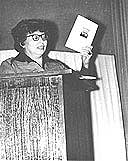The Museum
History of the Museum
1. The Main Steps of the Museum Activity
documents
chronicle
2.History of the scientific research
personalities
memoirs
1.N.A. Mayasova
2.O.V. Kruglova
restoration
3.History of the educational activity
Scientific Research
conferences and seminars
participation in the exhibitions
scientific works, articles
editions
restoration
expeditions:
-- archaeological
-- collecting monuments of culture and history
The educational activity
celebrations
excursion
participation in festivals, competitions, exhibitions
|
Memoir of the Museum Workers
Memoirs of Natalya Andreyevna Mayasova(page 3)
 The museum director was an original man. Many people in Zagorsk might remember him. His name was G.A. Sidorov-Oksky. He was an old Bolshevik, so he was not afraid of the authorities. He studied sculpture at the Higher State Art and Technical Studios at V. Mayakovsky’s time. Kind and intelligent, he wrote books for children and surrounded himself by writers, poets and artists. He helped many people, but actually he did not pay much attention to the Museum problems. He joked that he was “an ex-king with the ruling empress (he called me empress!). But at the time of the bureaucratic system it was luck that the director “did not interfere with work”.
The museum director was an original man. Many people in Zagorsk might remember him. His name was G.A. Sidorov-Oksky. He was an old Bolshevik, so he was not afraid of the authorities. He studied sculpture at the Higher State Art and Technical Studios at V. Mayakovsky’s time. Kind and intelligent, he wrote books for children and surrounded himself by writers, poets and artists. He helped many people, but actually he did not pay much attention to the Museum problems. He joked that he was “an ex-king with the ruling empress (he called me empress!). But at the time of the bureaucratic system it was luck that the director “did not interfere with work”.
So our small staff, disputing and quarrelling, built the Museum which was soon recognized all over the world. The group’s kernel included Chief Curator O.A. Belobrova ( worked between 1954 – 1964), a graduate of the Art History Department of the Leningrad University (now Candidate of Philology in Pushkin House); Head of History and Art Department since 1948 T.V. Nikolayeva (subsequently a famous scholar, Professor of History in the Institute of Archeology of the USSR Academy of Science); senior research worker T.N. Kedrova; Head of Folk Art Department, O.V. Kruglova (art historian) and her colleague, art historian L.E. Kalmykova. When A.M. Kedrova retired in 1958, E.N. Klitina was appointed in charge of the Museum depositories.
The well coordinated staff managed to overcome one of the most dramatic episodes of the Museum history, when in summer, 1954, General Secretary G.M. Malenkov, himself, signed the direction on passing the whole collection of the Museum treasures to the Armory Chamber of the Moscow Kremlin. Actually, it was the end of the Museum. We decided to struggle. Taking advantage of the lame preliminary arrival of the commission on our day off, we considered the circumstances and got ready. I was in the most difficult situation. I acted for the Director (Oksky was undergoing a course of medical treatment in sanatorium) and had to take the responsibility upon myself. But I had the secure rear. We agreed that those who would be present at the meeting would be reserved. I remember the short phrases I exchanged with the visitors (N.Ya. Nersesov from the Ministry of Culture, General A.Ya. Vedenin – Commandant of the Kremlin, Director of the Armory Chamber N.N. Zakharov and somebody else):
- Do you know why we have come? How shall we work?
— I’m sorry, but we won’t let the Sacristy go!
— Do you know that this is the Government resolution?
— Yes, but the Government is misled! We’ll explain. The Museum was founded by the Decree signed by V.I. Lenin himself.
— Is it your last word?
— Yes!
— Can we see the Sacristy?
— You are welcome, it is open for all people!
The official men said no more about their mission, neither did we.
|
|
|


